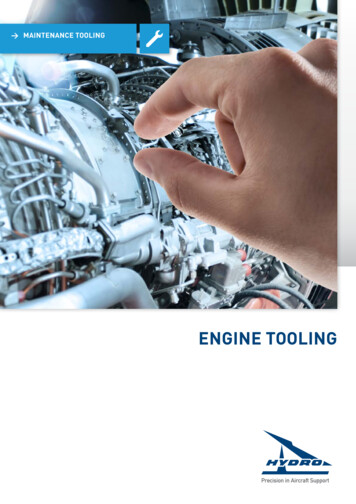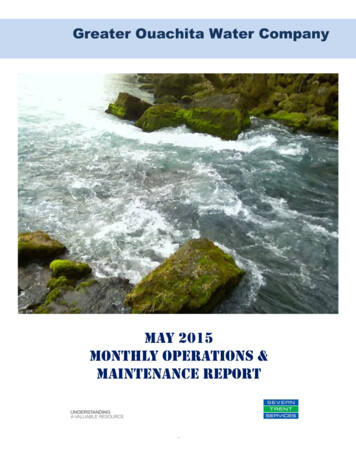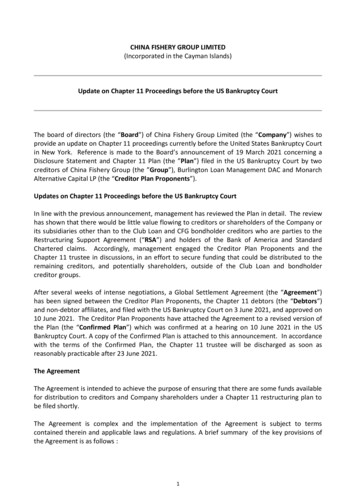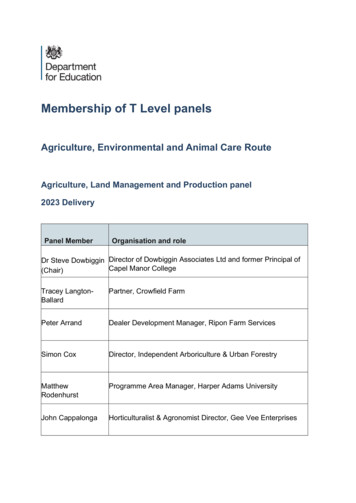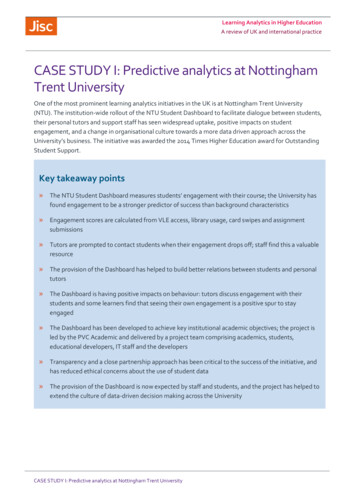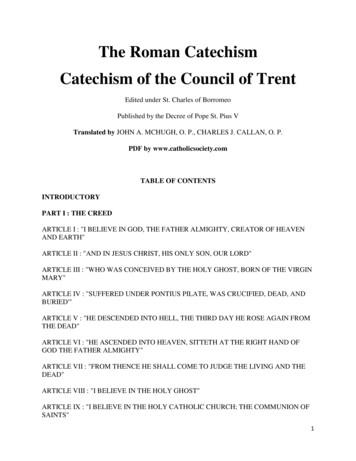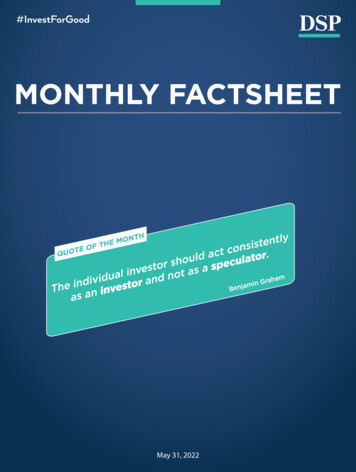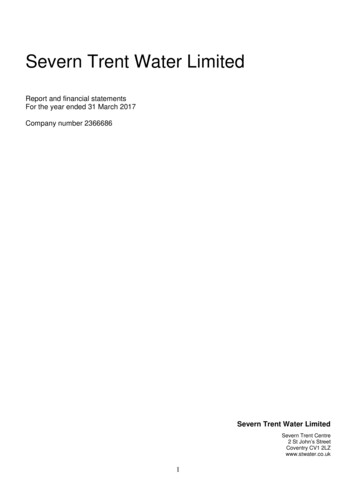
Transcription
Severn Trent Water LimitedReport and financial statementsFor the year ended 31 March 2017Company number 2366686Severn Trent Water LimitedSevern Trent Centre2 St John’s StreetCoventry CV1 2LZwww.stwater.co.uk1
ContentsStrategic reportWhat we do2016/17 highlightsChairman’s statementMarket and industry overviewChief Executive’s reviewHow we are achieving our strategyOperational reviewChief Financial Officer’s reviewRisk managementPrincipal risksCorporate Responsibility report344810141830374147GovernanceGovernance reportBoard of DirectorsDirectors’ remuneration reportDirectors’ reportDirectors’ Responsibilities Statement6063778286Group and Company financial statementsIndependent auditor’s reportGroup and company income statementGroup and company statement of comprehensive incomeGroup statement of changes in equityCompany statement of changes in equityGroup and company balance sheetGroup and company cash flow statementNotes to the Group and company financial statements88969798991001011022
Severn Trent Water LimitedStrategic ReportFor the year ended 31 March 2017Our VisionOur vision is to be the most trusted water company by 2020, delivering an outstanding customerexperience, best value service and environmental leadership.Our PurposeOur purpose is to serve our communities and build a lasting water legacy.Our StrategyWe aim to achieve these by meeting our strategic goals: Embed customers at the heart of all we do Drive operational excellence and continuous innovation Invest responsibly for sustainable growth Change the market for the better Create an awesome place to workOur ValuesWhile ensuring we live our values: We put our customers first We are passionate about what we do We act with integrity We protect our environment We are inspired to create an awesome companyWhat we doOur purpose is to serve our communities and build a lasting water legacy. We do this by providing cleanwater and waste water services and developing renewable energy solutions through our businessSevern Trent Water.The primary markets we focus on Wholesale operations and engineering Household customer servicesAbout usOne of the largest 10 regulated water and waste water businesses in England and Wales. We providehigh quality services to more than 4.5 million households and businesses in the Midlands and Wales.Where we operateOur region stretches across the heart of the UK, from the Bristol Channel to the Humber, and from Northand mid-Wales to the East Midlands.Key FactsTurnover 1,556.1mUnderlying profit before interest and tax 512.8mProfit before interest and tax 540.4mLitres of drinking water supplied each day1.85bnLitres of waste water treated per day2.6bnEmployees5,827Average during 2016/17Households and businesses served4.5mAlternative Performance Measures are defined in Note 3 to the financial statements on Page 107
Chairman’s statementCONTINUED PROGRESSGroup turnover 1,556.1m2016: 1,523.6mGroup underlying profit before interest and tax 512.8m2016: 498.5mGroup profit before interest and tax 540.4m2016: 499.5mGroup underlying profit before interest and tax up 2.9% year on yearFocus on operational improvementNet Reward 47.6m in 2012/13 prices pre taxFellow shareholders, this past year has been a successful one for Severn Trent. We are building ondelivering a fast start to Asset Management Plan 6 (‘AMP6’) and have seen excellent operational andfinancial performance. These strong results are built on the hard work of your management team instriving to deliver the best possible service to our customers and consistent returns to shareholders.Strength in times of turbulenceThe macro-economic environment of the past year has been turbulent, largely due to Brexit and the USelection. Our Company has been relatively sheltered from the impact of these, and has continued to offerstrength and stability. Our focus on delivering high quality service to customers and benefits toshareholders is showing significant results.AMP6 has allowed a platform for there to be winners in a world of incentivisation and we have fullyembraced this approach, driving operational performance higher, completing the year with excellentdelivery of customer Outcome Delivery Incentives (‘ODIs’) of 47.6 million. Customer ODIs aremaking us think differently to ensure we continually improve the service we provide to our customers andthis is helping us to achieve a step-change in, for example, sewer flooding performance.Our waste water business has been at the frontier of sector efficiency and we have made strides inaiming for upper quartile performance in water and retail. Whilst this is a multi-year journey our progressso far is encouraging. Achieving upper quartile in all three areas will improve the service and experiencewe offer to our customers and enhance the returns we can make in the next regulatory period.We continue to review the suppliers we work with to support us in delivery efficiencies. This means wehave stronger relationships with contractors who are now more aligned with the way we work.As regulation evolves we must continually look for ways to adopt and enhance our competitiveness andwe have been successful in embracing new markets. Earlier this year we announced the completion ofour acquisition of Dee Valley Water, a neighbouring water only company which operates in Wrexham,Chester and the surrounding areas. We welcome both Dee Valley Water’s customers and staff. Theintegration of Dee Valley’s operations is progressing well, and represents an exciting opportunity for usto deliver better service to all of our customers. Dee Valley’s and Severn Trent’s customers will benefitfrom sharing best practice from both businesses. The combined Severn Trent group will also benefitfrom a separate Welsh water licence and a stronger voice for our Welsh customers.4
We have been successful in establishing Waterplus – our ground-breaking joint venture with UnitedUtilities – in the non household retail market, which opened to competition in April 2017.Our regulator has signalled that further competition, for example in the opening up of the waterresources and bio-resources markets, will be considered in the coming years and we believe we will bein a strong position to respond to these opportunities.This is an exciting time to be an engineer at Severn Trent; innovation in research and development isenabling further operational excellence, and we’ve reached major milestones in improving the resilienceof our water network during the year. The first of two new reservoirs has been brought into service atAmbergate, where we are replacing and increasing the capacity of storage at the site.We have also seen the breakthrough of the 1.8 km Bleddfa tunnel boring element of the BirminghamResilience Project. I personally visited the Elan Valley during the year to see the great work being carriedout, which will secure the supply of water to Birmingham for the next 100 years.I know I speak for all our employees when I say that, at Severn Trent, we take pride in ourenvironmental, societal and governance credentials. We are making continued strategy progress on ourrenewables agenda.Self-generation of energy is the right thing to do for the environment and makes good financial sense forSevern Trent. We are now generating the equivalent of 34% of our energy needs and are on track forour target of 50% by end of AMP.Delivering returnsWe delivered strong financial performance this past year and I am pleased to announce that total SevernTrent Water Group turnover increased by 2.1% to 1,556.1 million, while underlying PBIT increased by2.9% to 512.8 million and reported PBIT increased by 8.2% to 540.4 million.Investing for the benefit of customersWe are committed to investing for the benefit of customers and are pleased to have made progress inour plans to invest the 120 million we announced last year in enhancing water quality, assistance tovulnerable customers, and security.Innovation in research and development is enabling further operational excellence and over the courseof AMP6 we are investing over 3,000 million in our assets for the future of our network. We are alsocommitted and on track to invest 190 million in our renewables business.Our colleaguesThe strong operational and financial performance delivered this year is the result of the hard work anddedication of my colleagues and reflects incentives being firmly aligned with Company objectives.I am also proud to report our progress on diversity. Our Board is now 44% female and the executiveteam 60%. However, we recognise that there is more work to be done to ensure that our leaders and ourworkforce are representative of the customers we serve, so we remain focused on increasing thenumbers of women in operational leadership positions; women and BAME (Black, Asian and MinorityEthnic) people in engineering positions; and BAME people in technical operator positions.Severn Trent has been voted as a Top 100 Apprenticeship Employer 2016 and we have been ranked24th globally in the Equileap Gender Equality Global Report and Ranking. We were also regionalwinners in the National Apprentice awards.During the year we bade farewell to two Board members and welcomed two more to the Board of SevernTrent. Martin Lamb and Gordon Fryett stepped down after many years of great service and we5
welcomed Kevin Beeston as our Senior Independent Director and Dominique Reiniche as aNon‑Executive Director.Looking forwardBeing a part of the regulatory debate ensures Severn Trent is prepared for any changes on the horizon.We also believe that this helps ensure continuity and consistency in delivery. With two years of AMP6now having passed we have started looking at the next regulatory period and driving to be in the rightposition now.We begin our customer consultation shortly and want to continue to be shapers and changers of theregulatory world in which we operate.There is much more to do. However, we are both ambitious and confident of achieving all theexpectations of our stakeholders.Andrew Duff,ChairmanCase studyDelivering our vision and purpose through our strategy and valuesSERVING OUR COMMUNITIESNumber of customers educated 167,024This year we have completed just over 700 educational visits to our customers talking about waterefficiency and how to be sewer savvy. This equates to 125,705 people in our communities. The visitsconsisted of 532 schools where we carried out assemblies and classroom workshops, and 76 visitsto our education centres at Hayden in Cheltenham and Derby. Visitors are educated on our two keymessages and then taken on a tour of the sewage treatment works.The remaining 95 visits were out in the community talking to groups such as the Womens’ Institute orretired engineers, landlord associations and housing associations. We have created some greatpartnerships this year, in particular the independent living group in Gloucester. The group help youngpeople get ready for living on their own. We have worked with the students to share our messagesand then as part of a project they have been out into their local community to share the message.6
Market and industry overviewThe water and waste water industryThe water and waste water industry in England and Wales is made up of 17 regional suppliers, whobetween them serve around 50 million household and non-household customers. Ten of thesecompanies, including our regulated business, Severn Trent Water Limited, provide both water and wastewater services. The remaining seven provide water only.The challenges facing our industrySince the industry was privatised in 1989, it has delivered real improvements for customers. Thecompanies have invested hugely in their networks, found smart new ways of working and become moreefficient. For example, since the mid 1990s industry-wide leakage is down by 35% and in the last 10years sewer flooding is down by 75%, while 99.97% of drinking water and 98.6% of bathing waters nowmeet European Union (‘EU’) standards.However, the industry still needs to tackle some major challenges in the coming years. First, customers’expectations are continuing to increase and we need to continue to improve the experience we deliver.People expect to be able to interact with their water companies at a time that’sconvenient for them, using the channels they prefer. That’s why Severn Trent wants to lead in digital, sowe can serve customers 24 hours a day and make best use of channels such as social mediaand webchat.We also need to make sure our assets can withstand whatever the future may bring. Climate change islikely to cause more periods of drought and flooding, so the industry needs to ensure it can provideits services, no matter what the weather is like. Severn Trent’s plans commit us to making our networkmore resilient, to cope with greater extremes in our climate. For example, our 300 million BirminghamResilience Project will protect the water supply for the UK’s second largest city.Although the industry has invested more than 108 billion since privatisation, it still needs to repair andreplace sewers, pipes and other assets that in some cases are more than a century old. During ourcurrent five year plan, Severn Trent will invest over 3,000 million in our assets, so the next generationcan benefit from even better services.We also need to cope with a growing population. The Office for National Statistics estimates that thepopulation of England and Wales will increase by over 9 million people by 2040. At the same time,the government is looking to significantly increase house building over the next few years. All of thismeans that more homes and businesses will need our services. We have to invest carefully, to ensurewe can meet those needs.We are delighted to have received Utility of the Year from the Home Builders Federation in October2016.As we’re working to overcome these challenges, we also need to keep bills affordable for customers,especially for those on the lowest incomes, and ensure we have the money we need to fund ourinvestment over the long term. This will allow us to deliver for customers and create value for investors.The industry’s regulatory frameworkThe Government’s approach to our industry is set by the Department for the Environment, Food andRural Affairs (‘Defra’) in England and the Welsh Government in Wales.Ofwat is the industry’s economic regulator. This means it sets limits on the prices we can charge ourcustomers over five year AMP cycles. This financial year was the second of AMP6, which runs fromApril 2015 to March 2020.7
We also work closely with a variety of other regulators and public bodies: The Drinking Water Inspectorate (‘DWI’) independently checks that water supplies in Englandand Wales are safe and that drinking water quality is acceptable to consumers.Its work includes testing water quality, ensuring companies make the changes necessary toimprove, developing new regulations to further improve water quality, and science and policy. The Consumer Council for Water (‘CCW’) speaks on behalf of water consumers in England andWales. It advises consumers and takes up complaints on their behalf. The Environment Agency (‘EA’) allows us to collect water from reservoirs, rivers and aquifers andreturn it to the environment after it’s been used by our customers and treated by us. Natural Resources Wales is the environmental regulator in Wales.It oversees how the country’s natural resources are maintained, improved and used now and inthe future. Natural England advises the Government on the natural environment in England and helps toprotect nature and the landscape, especially for plant and animal life in fresh water and the sea. The Health and Safety Executive helps us to reduce the health and safety risks faced by ouremployees, customers and visitors.The continuing evolution of regulationOfwat’s last review of the industry’s pricing was in 2014. That price review resulted in the most importantchanges in the industry’s economic regulation since privatisation. It gave customers a muchstronger voice in determining companies’ plans and introduced Outcome Delivery Incentives (‘ODIs’),which encourage companies to deliver what customers want using performance-related rewardsand penalties. Ofwat also encouraged companies to look at the whole life costs of their assets, ratherthan separately looking at how much to invest in them and how much they cost to run. This total cost isknown as Totex. Companies also have stronger incentives to become even more efficient.The next price review is in 2019 (‘PR19’) and Ofwat has already begun to shape its approach. In May2016, it published its Water 2020 framework, which set out how it proposes to regulate the sectorat PR19. This included increasing the number of price controls, to allow it to look at companies’ costbases in more detail and promote competition in areas such as water resources and bio-resources, aswell as using the Consumer Price Index to index prices rather than the higher Retail Price Index.Much of the industry’s investment is funded by borrowing, so interest rates can have an important effecton companies’ costs. In September 2016, Ofwat published its proposals on the cost of debt. This wouldautomatically adjust prices for customers if interest rates are different from those Ofwat assumed for newdebt. In December 2016, Ofwat outlined how ODIs could be made better in PR19. The proposal couldinclude larger rewards for companies that perform well, with larger penalties for companies who fallshort. Ofwat is expected to publish a consultation on its approach to the next price review in the summerof 2017.The most significant change to regulation in this AMP has been the introduction of retail competition fornon-household customers in England, from April 2017. This allows businesses and other non-householdorganisations to shop around for the best deal in water supply. We have responded by creating theWaterplus joint venture and making the necessary changes to our systems and processes to allow ourwholesale water business to supply retail water providers (see page 26).In the longer term, the household retail market could also be opened to competition in England. The UKGovernment has said it first wants to see how retail competition works for non-household customersbefore making any decisions.Contributing to the regulatory debateWe believe it’s important that we put forward our views about how regulations should develop and wehave a long track record of helping to shape the future of our industry.8
We remain very supportive of the general direction of Ofwat’s proposals. We’ve embraced ODIs, sowe’re well placed as Ofwat looks to refine how they work. In April, we released the latest in our series ofCharting a Sustainable Course publications, which sets out how we believe incentives can bemade to work better at the next price review for all stakeholders, including customers. This builds onOfwat’s own consultation document.We’re also in favour of moves towards trading in bio-resources (a by-product of the sewage treatmentprocess) and water resources. We’re already exploring the potential for trading bio-resources withother water companies, and we see this area as an exciting opportunity for us and our customers.Trading water resources is a longer term prospect, which could provide a relatively low cost andenvironmentally friendly way of sharing water across regions. However, we also consider that anychanges to how water is supplied need to form part of a wider package of measures including reducingdemand for water.How our customers and the external environment influence our strategyOur strategy for AMP6 is designed to meet the challenges posed by our changing environment andregulation: Our strategy embeds customers at the heart of all we do. This ensures we continue to meet theirneeds as they evolve. Operational excellence and continued innovation help us to deliver the service customers rely on,while ensuring we keep bills affordable for all, both now and in the future. It is essential that we have a resilient, well-maintained network, which can meet the demands of agrowing population and a changing climate, which is why we’re investing responsibly forsustainable growth. Changing the market for the better means ensuring we help shape changes to regulations andare well prepared for the opportunities and challenges it brings. Delivering on all of the above requires us to have inspired, talented and engaged people, which iswhy we’re creating an awesome place to work.Case studyDelivering our vision through our purpose, strategy and valuesBUILDING A LASTING WATER LEGACYEnsuring a resilient water supply for BirminghamFor more than a century, the Elan Valley Aqueduct has been Birmingham’s primary water source. Itcarries water all the way from the Elan Valley in Wales to Birmingham. It needs work to keep it fitfor the future but we can only turn it off for three days at a time. That’s why in March 2017, westarted building a new 25km pipe from Lickhill to our treatment works in Birmingham. When thenew pipe is ready in 2019, we can turn off the aqueduct for 50 days every other year and give it thecare it needs.We’ve identified work we need to do sooner, so we’re building three pipes to bypass parts of theaqueduct. The first completed in March, at Bleddfa. We’re working closely with local people, withregular drop-in sessions so we can work with the community and minimise disruption. We’ve alsoheld focus groups and taste tests, to understand how changing the water supply affects customers,which will inform our future approach.9
Chief Executive’s ReviewDELIVERING RESULTSLiv Garfield, Chief ExecutiveTwo years into the current regulatory period I’m pleased that, with the superb help and support of all mySevern Trent colleagues, we are becoming a truly customer focused business that continuesto invest in our future and deliver strong and sustainable financial performance.As a business we want to be the most trusted water company by 2020, and our customers have told usthat means delivering an outstanding customer experience with the best value service and showing trueenvironmental leadership.In the last year we have made progress in all three areas but of course there is always more to do.On customer experience we have made great progress in delivering against our agreed CustomerOutcome Delivery Incentives (ODIs). For example, this year on two measures that customers careabout most we have reduced supply interruptions by 17% and cases of external sewer flooding by 23%against our regulatory targets.We have achieved this while making sure that we continue to offer the lowest average combined waterand waste water bills in Britain, as well as increasing our commitment to support those customersmost in need.To help us focus on continuing to deliver best value service in the future we have worked hard to identifyfurther efficiencies and have increased the targeted Totex savings by 100 million to 770 million.Making these savings will help us towards our further ambitions to be upper quartile in performance andcost in retail, water and waste.Turning to environmental leadership, we are proud of the fact that we have had sector leadingperformance for two of the last four years. Furthermore, on renewable energy we are now generatingthe equivalent of 34% of our energy needs and are on track to self-generate 50% by 2020.I would love to take this public opportunity to welcome our new customers and colleagues from DeeValley Water. This strategic acquisition helps us grow our business and bring in new skills andexpertise to the wider company. We look forward to continuing to integrate our two businesses over thecoming months.Consistency and progressTo make sure that we make the right progress through this regulatory period to becoming the mosttrusted water company, we use our strategic framework as our route map to success.This framework focuses on five strategic objectives that we believe can deliver all of our ambitions, thefive are: embed customers at the heart of all we do; drive operational excellence and continuedinnovation; invest responsibly for sustainable growth; change the market for the better; and create anawesome place to work.Taking each of the five in turn, let me share some thoughts on how we are doing in each area.Embed customers at the heart of all we doWe are proud of the fact that for the second year we have outperformed against the commitments(‘ODIs’) that our customers most care about. Our customer service and operational improvements havecontributed to customer ODI rewards of 47.6 million. On top of the reduction in external sewer10
floodings and supply interruptions, we have also sustained our improved performance on category 3pollutions and leakage against our regulatory targets. Although we have seen tremendous progressacross many aspects of the business this year, there is more we can do to improve customerexperience. Whilst the number of customer complaints have declined since the start of the AMP thereremains more scope for further improvements. As such we are taking a more active approach toreducing problems occurring in the first place. For example, we have worked with customers to come upwith a re-designed bill which is easier to understand.As we look to make contact easier and more efficient, we now have around a third of our customersusing our 24/7 digital self-service, and we have also designed a new, easier to navigate customerwebsite.We are passionate about affordable bills for all and remain committed to supporting customers who mostneed our help. Through a range of schemes we have delivered our ‘Help When YouNeed It’ target that supported over 50,000 customers who were struggling with their payments.Drive operational excellence and continuous innovationWe are improving the productivity of our workforce, through better devices, connectivity and apps. Weare using digital technology and innovation to reduce risks through real-time water quality measurementand insight, along with active network modelling that helps us act quickly and reduce the number ofbursts and cases of premature asset deterioration. We have continued to refine our use of sensors andimproved analytics to prevent flooding and pollutions, as well as diagnosing and resolving jobs moreeffectively.We have embraced research and development as a key enabler for operational excellence, and a greatexample of our innovation leadership is our world-leading phosphorous removal trials. Being leaders inthis field is helping us save 10 million in this AMP.Invest responsibly for sustainable growthWe promised to leave no stone unturned in the pursuit for Totex efficiencies during the year, and throughthe tremendous work of our colleagues to seek better ways to run the business, we have identified anadditional 100m of efficiencies. This takes the total forecast efficiencies for this AMP to 770m (at2012/13 prices). Of this 770m, we’ve been able to announce that a further 70 million of Totexefficiencies have been locked in over the last six months, building on the 540 million we’dpreviously announced, and taking the total amounts locked in to 610 million. We are adamant that thesearch does not stop here however. We will continue to seek opportunities throughout the business todrive further efficiencies for the benefit of our customers and our shareholders.To help deliver improved customer service and a more efficient and resilient network, Severn Trent willbe spending around 1,400 for every property in our region over the course of AMP6.This year we have also taken steps to focus on to our core business with the acquisition of the DeeValley Water Group. We have welcomed our colleagues from Dee Valley Water, which serves 125,000properties, into the Severn Trent family, and we will spend the summer working through the integration ofour two businesses. This acquisition is a natural fit, and we are enjoying learning new skills from eachother as we look to collectively improve the customer experience.Our role as custodians of our network for customers today and for future generations is right at the heartof our strategy. During the year we have seen great progress on the Birmingham Resilience Scheme,our largest ever asset-creation programme. Critical milestones such as the Bleddfa bypass have nowbeen completed and we have also embarked on a large programme of customer engagement to supportthe next stage of the programme. We have also successfully met all DWI and EA obligation dates.11
We have delivered some important milestones in our renewables plan, including the completion of oursecond food waste anaerobic digestion plant at Roundhill, Staffordshire.We believe good businesses are socially responsible businesses and supporting our local community iscentral to our values. Highlights include the delivery of 12,000 water efficiency home checks to helpcustomers save money, educating 167,024 people on sewer misuse and water efficiency and beingrecognised by the Drinking Water Inspectorate as industry leaders for our innovative approach tocatchment management.Change the market for the betterAt the start of April 2017, we saw the opening of the non-household retail market and I am pleased withthe future prospects of Waterplus, our joint venture with United Utilities.We have engaged with all of our colleagues across the business to make sure they understand the newways of working in this new world of competition, and our focus on being a fantastic wholesaler for allretailers operating in our region.I was also very pleased that we have been recognised by our regulators for providing information to ourcustomers and stakeholders that they can trust. We are one of only three companies to receive ‘selfassured’ status in Ofwat’s annual review.Create an awesome place to workWhen I first joined the company I was
Company number 2366686 Severn Trent Water Limited Severn Trent Centre . Our waste water business has been at the frontier of sector efficiency and we have made strides in . Utilities - in the non household retail market, which opened to competition in April 2017.
